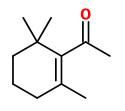Cycas revoluta Thunb. - Cycadaceae - sago Cycas,China Sago Palm, Japan Sago Palm, Japanischer Sagopalmfarn
Native to Japan, Formosa, China, cultivated in India; trunk 1.80m high, densely clothed with old leave bases; leaves 0.60-1.80m long, quadrangular, thick petioled; leaflets narrow, margins revolute; carpophylls 10-23cm long, blade ovate, laciniate nearly the midrib, stalk longer than blade with 4-6 ovules; immature seeds densely tomentose.
[Kirkitar KR, Basu BD, Indian Medicinal Plants, Vol. IV, Delhi 1975]
„It is one of several species used for the production of sago, as well as an ornamental plant.“ https://en.wikipedia.org/wiki/Cycas_revoluta
„Cycas revoluta is the most commonly cultivated cycad because of its ornamental appearance, hardiness, and adaptability.“
http://www.efloras.org/florataxon.aspx?flora_id=2&taxon_id=200005230
The scent of male and female cones of C.revoluta was described as strong and unpleasant. „…estragole (4-allylanisole) dominated in the volatiles (67.0-92.7%), with small amounts of other benzenoids, e.g., anethole, methyl salicylate, methyl eugenol, and ethyl benzoate. Several fatty acid esters were also detected in the samples from Iriomote Island.“
[Estragole (4-allylanisole) is the primary compound in volatiles emitted from the male and female cones of Cycas revoluta., Azuma, H., Kono, M., Journal of plant research, 119(6), 2006, 671-676]
A scent sample trapped from C.revoluta contained also estragole (33.0%) as dominating compound, together with β-cyclocitral (21.2%), isoamyl acetate (16.4%), acetoin (5.7%), and some anethole (2.7%). An old male specimen from Yunnan showed the enormous olfactory contribution made by some 3-isobutyl-2-methoxypyrazine (0.01%, earthy, bell-pepper-related), a compound found at 87% in the headspace of Cycas circinalis.
[Scent of a vanishing flora, Roman Kaiser, 2011, 338-339]
„Bark boiled in water is used to wash burns.“
[Medical ethnobotany of the Marma tribe of Bangladesh., Alam, M.K., Economic Botany, Vol.46(3), 1992, 330-335]
„Skin infections. Leaves are crushed and applied to affected areas. Precautions: must not be applied too frequently.“
[Ethnomedicinal survey of Bheramara area in Kushtia district, Bangladesh., Rahmatullah, M., Ferdausi, D., Mollik, M.A.H., Azam, M.N.K., Rahman, M.T., Jahan, R., American Eurasian Journal of Sustainable Agriculture, Vol.3(3), 2009, 534-541]
„Cycasin, a new toxic glycoside, C8H16O7N2, has been isolated from the seeds of Japanese cycad, ion-exchange resins and active carbon chromatography being used. From the results of the examination of the decomposition products such as nitrogen gas, formaldehyde, and cyanide etc. and of the ultraviolet and infrared absorption spectra, its aglycone is considered to be identical with that of macrozamin from Australian cycad, reported by Lythgoe et al. It is found, however, that the sugar component of cycasin is one molecule of glucose, unlike that of macrozamin namely primeverose. Cycasin is, therefore, concluded to be a new compound, glucosyloxyazoxymethane.“
[12. Studies On Cycasin, a New Toxic Glycoside, of Cycas revoluta Thunb: Part 1. Isolation and the Structure of Cycasin., Nishida, K., Kobayashi, A., Nagahama, T., Journal of the Agricultural Chemical Society of Japan, VOl.19(1), 1955, 77-84]
„The seeds of cycads contain cycasin and neocycasin, which belong to the family of cyanogenic glycosides. These glycosides of cycads are considered pseudocyanogenic with little potential to liberate hydrogen cyanide as other cyanogenic glycosides do. This study investigated the clinical spectrum of Cycas seed poisoning and its cyanogenic potential. Methods: This was a retrospective chart review conducted at the Poison Control Center in Taiwan (PCC‐Taiwan) from 1990 to 2001. Results: Twenty‐one cases of Cycas seed poisoning were identified. The reasons for seed ingestion were misuse as an edible food (70%), health promotion (10%), cancer prevention (10%), cosmetic use (5%), and gastrointestinal discomfort (5%). All patients had eaten the seeds after washing and cooking them. The time from ingestion to the onset of symptoms ranged from 30 min to 7h (mean 2.8h); patients had ingested between 1 to 30 seeds. Respiratory depression did not occur. Severe vomiting was the most striking symptom. All patients except one presented with gastrointestinal disturbance, and 90% sought medical care at the emergency department. Within 24h, all patients had recovered. Six patients had blood cya nide or thiocyanate levels measured. Although the levels were higher than normal, they did not reach the toxic range. Conclusions: The cyanogenic potential of Cycas seeds is documented in our cases. The gastrointestinal symptoms were severe enough that most patients sought medical attention but recovery was quick and complete.“
[Acute Cycas seed poisoning in Taiwan., Chang, S.S., Chan, Y.L., Wu, M.L., Deng, J.F., Chiu, T.F., Chen, J.C., Tseng, C.P., Clinical Toxicology, Vol.42(1), 2004, 49-54]
„Since diverse taxa of cyanobacteria has been linked to biosynthesis of BMAA, a controversy has arisen about the detection of neurotoxic amino acids in cyanobacteria… The investigation of overall 62 cyanobacterial samples of worldwide origin by application of this method revealed the absence of BMAA, whereas seeds of Cycas revoluta contained 6.96 μg g−1 of free BMAA.“
[LC–MS/MS determination of the isomeric neurotoxins BMAA (β-N-methylamino-l-alanine) and DAB (2, 4-diaminobutyric acid) in cyanobacteria and seeds of Cycas revoluta and Lathyrus latifolius., Krüger, T., Mönch, B., Oppenhäuser, S., Luckas, B., Toxicon, Vol.55(2), 2010, 547-557]

Cycas revoluta. Funchal, Madeira, Portugal
CC BY-SA 4.0, Author: Luis Miguel Bugallo Sánchez (Lmbuga) Wikimedia Commons


